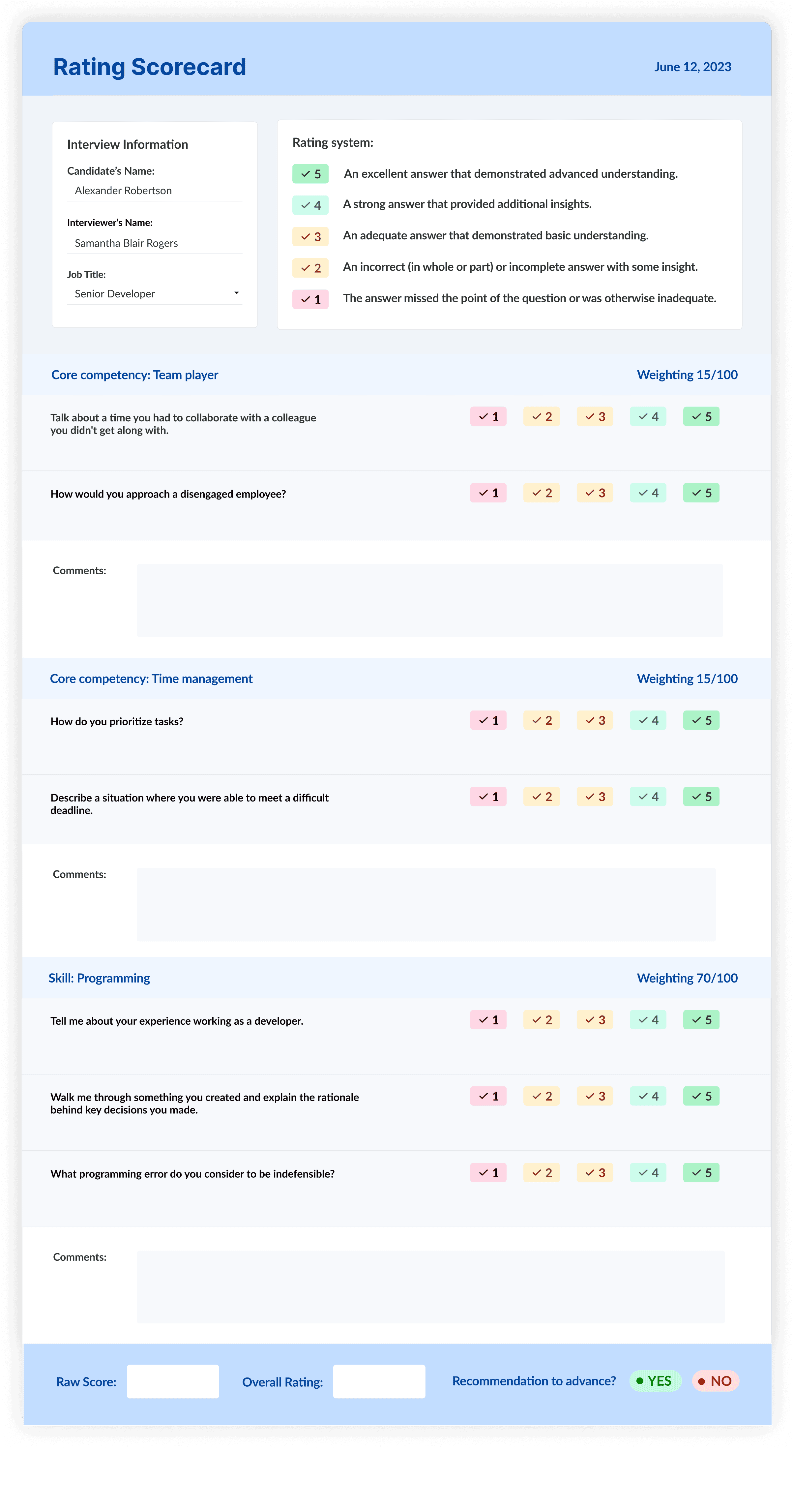
What Is an Interview Scorecard and How to Make One
Written by
Lauren BarberAbout the Author
Lauren is a Senior Content Manager at VidCruiter, with expertise in technology and human resources. She is celebrated for her contributions to Forbes, Fast Company, Meta, Lyft, and McCain.
Reviewed by
VidCruiter Editorial TeamAbout the Author
The VidCruiter Editorial Team offers practical recruitment advice, drawing on insights from seasoned professionals. Our award-winning content, supported by industry specialists, underscores VidCruiter's dedication to innovation in recruitment.
Last Modified
Mar 25, 2024An interview scorecard is a tool interviewers use to objectively rate candidates’ suitability for a position based on pre-determined criteria and competencies. They include rating scales, notes on candidate answers, and recommendations about next steps. When used as a part of a structured interview process, this tool can benefit your organization in a variety of ways.
What Is an Interview Scorecard?
An interview scorecard — also known as an interview scoring sheet, rating guide, interview rubric, hiring scorecard, or candidate scorecard — is an assessment tool used in structured interviewing to standardize applicant evaluations. They evaluate all candidates against the same criteria to determine if they have the necessary skills and competencies for a role.
Once all candidates have been interviewed and rated, typically the hiring manager looks at the results, discusses scores with other panelists if it was a panel interview, and decides who moves forward.
An interview scorecard is part of an interview guide, which contains the information an interviewer needs to conduct a structured interview for a specific position.

Learn how to set up a structured interview process
Download The Modern Guide to Structured InterviewingWhat’s Included in an Interview Scorecard?
Interview scorecards, or hiring scorecards, are part of a structured interview process. The hiring scorecard’s content is based on the interview questions and the pre-determined skills and competencies identified in the job analysis.
Here’s what you’d see on a score sheet for a job interview:
- Scales for each job-specific competency or question
- Spot for interviewer notes
- Recommendation about next steps
- Overall score
When Should an Interview Scorecard Get Filled Out?
The most accurate way to fill out an interview scorecard is during the interview. Rating as you go before moving on can decrease opportunities for hiring bias.
“[Rating as you go] neutralizes a variety of biases: We are more likely to remember answers with vivid examples, for example, and answers that are most recent. Evaluators who wait until the end of the interview to rate answers risk forgetting an early or less-vivid but high-quality answer, or favoring candidates whose speaking style favors storytelling.”
Iris Bohnet
Benefits of Using an Interview Scorecard
Here are several reasons to consider using an interview scorecard:
Interview Scorecards Can Make the Process More Equitable
Interview scorecards remove subjectivity. They assess everyone against the same criteria while accounting for accommodations, making the process fairer.
Interview scorecards can also improve interview compliance by making it easier for interviewers of all levels to follow best practices and harder to stray from the process (thanks to settings in the platform).
What is interview compliance?
Interview compliance is a framework that ensures all interviews adhere to proven methods and procedures, maximize effectiveness and fairness, and remain responsive to legal, ethical, and social values.
Interview Scorecards Can Prove That Your Hiring Practices Are Fair
Interview scorecards serve as formal documentation that can make your decisions more legally defensible. Rating data can demonstrate why certain hiring decisions were made and prove they weren’t discriminatory.
When used correctly, interview scorecards can also prevent adverse impact or discrimination claims from happening because they are a fair way to evaluate candidates.
Interview Scorecards Can Increase Your Quality of Hire
A well-designed interview scorecard gives interviewers a much better chance of choosing a quality candidate. Why? Interview scorecards are part of a structured interview process. McGill University found that structured interviews improve accuracy, making them a strong way to detect future job performance.
Another thing to consider is that everything on an interview scorecard is directly related to the role you are hiring for. By only measuring the things that matter, you can collect better data and make better hiring decisions.
Interview Scorecards Can Encourage Collaborative Hiring
Making an interview scorecard gets everyone on the same page about what an ‘ideal’ applicant would bring to the role.
For panel interviewing, standardizing the rating process makes it easy to compare scores. Diverse opinions and scores then open up the discussion about who should move forward and why.

Interview Scorecards Can Accelerate Time to Hire
When combined with interview questions that predict future performance, an interview scorecard can help you figure out who is right for a role much faster.
First, isolate the most effective questions and put them earlier in the process. From there, weigh the ratings associated with these questions heavier on the interview scorecard. This is especially helpful when candidates are very close because you can compare their performance on these specific questions to expedite the process.
With interview scorecards, there is also a cadence that is established through repetition. Interviewers get more efficient at rating the more they use scorecards, and hiring managers come to understand how to use scores to make decisions efficiently.
Interview Scorecards Can Reduce Opportunities for Bias
Standardization is a very effective way to reduce bias. Interview scorecards allow employers to offer a repeatable and objective evaluation experience.
Preventing hiring bias using interview intelligence
Consider leveraging AI to identify interviewer scoring habits that may be a result of unconscious bias. Interview intelligence can help by pointing out rating tendencies, coaching interviewers to course correct, and setting your structured interview process up for continuous improvement.

Interview Scorecards Measure Candidate Consistency
When you use interview scorecards, each step of the interview process is assigned a score. This allows hiring managers to compare each step of the candidate’s journey to confirm they’ve performed well throughout the process based on data, not on hindsight.
How to Make an Interview Scorecard
Design an interview scorecard (aka recruiting scorecard) template so hiring managers all over the organization can adopt this practice and create specific scorecards for each position. For every role-specific scorecard you make, you can keep it for the future when you’re rehiring for that same job.
1. Start With a Structured Interview Process
When created correctly, recruiting scorecards don’t exist on their own — they are an important part of a structured interview process. If your organization isn’t already using structured interviewing, this is your sign to look into it!
In order to make a recruiting scorecard you’ll first need the following things:
- 4-6 role-related criteria, skills, or competencies
- 1-2 additional scoring categories and scales*
- Interview questions
- Job description
*Could be competencies directly related to organizational objectives or values. These would be standard in all scorecards across the organization.
Everything in the list above relies on information from the job analysis, which the U.S. Office of Personnel Management describes as “the foundation for all assessment and selection decisions.”
2. Define your scales
Every scorecard needs rating scales that align with each question.
There are three common types of scales:
Likert scale
Likert scales measure opinions, perceptions, and behaviors. Each number provides a detailed description of the associated competency level.
Behaviorally Anchored Rating Scale (BARS)
BARS scales require the interviewer to compare the candidate’s answers about past or future behavior against behaviors sorted according to levels of competency (usually from 1 to 5, with 1 representing the unideal behavior). The descriptions in this scale are based on real experiences.
Behavioral Observation Scale (BOS)
Similar to BARS, BOS is a behavior-based measure used in relation to situational questions to evaluate performance.

3. Outline the Scoring System and Advancement Protocols
Determine how you will aggregate the evaluation data. Will you manually tally everything in a spreadsheet, or are you using a digital rating guide that automatically compiles and saves everything? If it was a panel interview, leave time for a collaborative discussion about who to advance.
Next, decide if you’ll advance all candidates who achieve a certain score or the top 3-6 candidates. Determine these parameters in advance and alter them as needed once hiring is complete.
What makes a good hiring scorecard?
Here are some factors that determine the level of structure and strength of an interview scorecard:
- Based on job analysis
- Competencies align with the job description
- Scores are well defined
- Contains 4-6 skills and competencies that are specific to the job, plus 1-2 that are assessed for across the organization
How to Use Interview Scorecards Effectively
Simply creating an interview scorecard or candidate scorecard, isn’t enough. How it’s used impacts how effective it will be. Here are some things to consider if you want a candidate scorecard to be used properly.
Train Interviewers on Note-Taking and Using the Candidate Scorecard
Train interviewers to avoid capturing inferences or judgments in their interview notes. When writing notes, interviewers should focus on what the candidate is describing, when it took place, what they did, or would do, and the results. Focus only on what they are saying, and avoid letting other details sway your rating.
Explain Candidate Scorecards to Candidates
Put candidates at ease and improve their experience by explaining what you’re looking for and how you’ll be assessing them at the beginning of the interview. Don’t forget to ask if they have any questions.
Create a Candidate Scorecard Template
Once you’ve created and tested a scorecard for a position, make it into a scorecard template. This can save a lot of time, especially if you hire for that role frequently. Create templates for all roles so the entire organization can realize the benefits of candidate scorecards.
Interview Scorecard Example

Frequently asked questions
What Is a Resume Score?
A resume score is based on the contents of a candidate’s resume, not interview answers and performance. Many Applicant Tracking Systems use AI to check and organize resumes. Depending on the platform, humans select candidates to interview from a suggested shortlist, or AI advances candidates.
Scoring resumes this way can speed up the process, but it’s considered high risk to leave decision-making entirely in the hands of AI. The decisions could be based on biased data, and it can be hard to understand the algorithm’s choices. Employers are equally as responsible as AI vendors if discrimination occurs, which is why giving AI this responsibility is high risk.
Should Interview Responses Be Scored?
If you want to put interviewing best practices into place in your process, the short answer is yes. In order to be compliant, a candidate’s answers must be scored using a standardized rating guide and submission process.
If it’s a panel interview, questions should be rated independently during the interview to prevent the introduction of bias.

E-BOOK
The Modern Guide to Structured Interviewing
Get your free copy of VidCruiter’s comprehensive white paper about structured interviewing. This practical guide:
-
Shows you how you can use technology to optimize your hiring
-
Teaches you how to develop and conduct a structured interview process
By providing email address, you agree to receive updates
from Vidcruiter.
Read our Privacy Policy.



